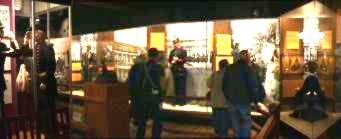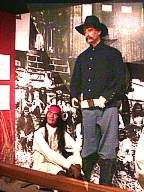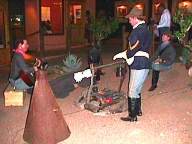Fort
Huachuca
The Story of
Army Intelligence
Sierra
Vista, AZ
January 31, 2001
While  visiting
in Sierra Vista, AZ. we were invited by an old army buddy to
visit Fort Huachuca's (Wa-chu-ka) museums. This military
installation was of particular interest to me as my father had
been stationed there for a brief time during WW II. My parents
lived in Bisbee for a while and then moved to Tombstone. I can
remember as a child hearing stores of the old west and life in
Arizona. The Fort was created in March of 1877 by the 6th US
Cavalry as a protection for the local ranchers from marauding
Apaches headed up by a particularly aggressive Chief named
Geronimo. The Fort soon became home to the famous "Buffalo
soldiers", the all black Cavalry unit of the army. Today
much of its size has been reduced but the Fort is none the less
an active intregal part of our Nation's defense system. It houses
several sections of army intelligence
visiting
in Sierra Vista, AZ. we were invited by an old army buddy to
visit Fort Huachuca's (Wa-chu-ka) museums. This military
installation was of particular interest to me as my father had
been stationed there for a brief time during WW II. My parents
lived in Bisbee for a while and then moved to Tombstone. I can
remember as a child hearing stores of the old west and life in
Arizona. The Fort was created in March of 1877 by the 6th US
Cavalry as a protection for the local ranchers from marauding
Apaches headed up by a particularly aggressive Chief named
Geronimo. The Fort soon became home to the famous "Buffalo
soldiers", the all black Cavalry unit of the army. Today
much of its size has been reduced but the Fort is none the less
an active intregal part of our Nation's defense system. It houses
several sections of army intelligence  including an electronic surveillance unit. This
was particularly nice for my walking mornings, as on most days
they flew a surveillance blimp a thousand feet or so in the air
at the east end of the base about 2 and half miles from the
trailer park. It made a delightful navigational beacon both day
and night. The Mexican border is only a few miles away where such
balloons are employed spotting undocumented crossings of the Rio
Grande on foot. One museum houses some interesting artifacts from
Army
including an electronic surveillance unit. This
was particularly nice for my walking mornings, as on most days
they flew a surveillance blimp a thousand feet or so in the air
at the east end of the base about 2 and half miles from the
trailer park. It made a delightful navigational beacon both day
and night. The Mexican border is only a few miles away where such
balloons are employed spotting undocumented crossings of the Rio
Grande on foot. One museum houses some interesting artifacts from
Army  Intelligence.
It featured Captain Parker Hitt who was 34 years old in 1911 when
the Signal school at Fort Leavenworth conducted its first
conference on military cryptology. The infantry officer had
interrupted his studies in civil engineering at Purdue university
to join the Army in 1898. He served in the Philippines, Alaska
and California before attending the Signal School and then
becoming an instructor at the institution. He possessed a flair
for solving ciphers and deciphered coded messages intercepted
from Mexico from both the agents of Pancho Villa and the
Constitutionalists, the latter code becoming known as the Mexican
Army Cipher Desk. As a Colonel, Parker Hitt went to France with
the American Expeditionary Force and served on Pershing's staff
before becoming the Chief Signal Officer for the 1st Division.
Hitt wrote the U.S. Army's first publication on cryptology in
1915 when his Manual for Solution of Military Ciphers was printed
at Fort Leavenworth. From 1914 to 1917, Hitt developed a code
machine that,
Intelligence.
It featured Captain Parker Hitt who was 34 years old in 1911 when
the Signal school at Fort Leavenworth conducted its first
conference on military cryptology. The infantry officer had
interrupted his studies in civil engineering at Purdue university
to join the Army in 1898. He served in the Philippines, Alaska
and California before attending the Signal School and then
becoming an instructor at the institution. He possessed a flair
for solving ciphers and deciphered coded messages intercepted
from Mexico from both the agents of Pancho Villa and the
Constitutionalists, the latter code becoming known as the Mexican
Army Cipher Desk. As a Colonel, Parker Hitt went to France with
the American Expeditionary Force and served on Pershing's staff
before becoming the Chief Signal Officer for the 1st Division.
Hitt wrote the U.S. Army's first publication on cryptology in
1915 when his Manual for Solution of Military Ciphers was printed
at Fort Leavenworth. From 1914 to 1917, Hitt developed a code
machine that,  after some improvements by Joseph Mauborgne,
Chief of the Signal Corps' Engineering and Research Division
would become, in 1922, the Army's M-94. It was used up until WW
II. In the 1930s it was replaced by the M-138a, which
incorporated some more improvements on Hitt's prototype. His hand
crafted prototype is on display. The Corps of Intelligence Police
formed in World War I was renamed the Counter Intelligence Corps
(CIC) in 1942. In the U.S. the CIC was responsible for the
security of the Manhattan Project, the secrete scientific work on
the atomic bomb, and performed censorship duties for all mail
arriving from overseas. Counter Intelligence Corps detachments
were assigned to each Army division in the North African,
European and Pacific theaters,
after some improvements by Joseph Mauborgne,
Chief of the Signal Corps' Engineering and Research Division
would become, in 1922, the Army's M-94. It was used up until WW
II. In the 1930s it was replaced by the M-138a, which
incorporated some more improvements on Hitt's prototype. His hand
crafted prototype is on display. The Corps of Intelligence Police
formed in World War I was renamed the Counter Intelligence Corps
(CIC) in 1942. In the U.S. the CIC was responsible for the
security of the Manhattan Project, the secrete scientific work on
the atomic bomb, and performed censorship duties for all mail
arriving from overseas. Counter Intelligence Corps detachments
were assigned to each Army division in the North African,
European and Pacific theaters, with a total of 241 CIC detachments operating
during the war. Overseas the CIC secured captured enemy
headquarters, interrogated prisoners, and impounded enemy
documents. They arrested or surveilled any suspected enemy
agents. They surveyed and protected public utilities, supply
depots and other potential targets of sabotage. They seized radio
stations and telephone switchboards, halting all communications
and turning over any communications data to the Signal Corps
personnel. They shut down presses and seized mail for censorship
teams. They cooperated with local provost marshals on matters of
law and order. CIC operatives familiarized themselves with the
local economic, political and social conditions and cultivated
well placed informants. I was particularly delighted to find one
of the infamous "Enigma" coding machines who's part has
been the subject of many a great spy story of the WW II era.
Secure radio communications are indispensable in modern war. To
safeguard their messages, the Nazi forces relied on the Enigma
machine, a compact, battery-powered Electro-mechanical cipher
device. The three rotors of the version of the enigma used by
most elements of the Wehrmacht permitted 1,560,000 permutations
for each character. Additional security was provided by a
plug-board which further
with a total of 241 CIC detachments operating
during the war. Overseas the CIC secured captured enemy
headquarters, interrogated prisoners, and impounded enemy
documents. They arrested or surveilled any suspected enemy
agents. They surveyed and protected public utilities, supply
depots and other potential targets of sabotage. They seized radio
stations and telephone switchboards, halting all communications
and turning over any communications data to the Signal Corps
personnel. They shut down presses and seized mail for censorship
teams. They cooperated with local provost marshals on matters of
law and order. CIC operatives familiarized themselves with the
local economic, political and social conditions and cultivated
well placed informants. I was particularly delighted to find one
of the infamous "Enigma" coding machines who's part has
been the subject of many a great spy story of the WW II era.
Secure radio communications are indispensable in modern war. To
safeguard their messages, the Nazi forces relied on the Enigma
machine, a compact, battery-powered Electro-mechanical cipher
device. The three rotors of the version of the enigma used by
most elements of the Wehrmacht permitted 1,560,000 permutations
for each character. Additional security was provided by a
plug-board which further  scrambled each letter. Messages keys were
changed every 24 hours. The German High Command felt that the
Enigma was unbreakable. They gambled everything on the
cryptographic security of the "Glowworm" machine, as
the Enigma was sometimes called. Fortunately for the course of
the world history, they lost. The secret of the Enigma was broken
early in World War II by expert British crypto-analysts working
out of temporary huts on the grounds of Bletchiey Park, an
English country mansion. The British were able to build on prior
work by the Poles and the French. The fact that the Enigma had
been broken was a closely guarded secret for 30 years. The
intelligence obtained by decrypting Enigma messages and other
high-level systems was known as ULTRA and was disseminated under
the closest controls. When the Unites States joined the war, this
intelligence was shared. Ultimately, US Army detachments helped
in the effort. ULTRA gave Eisenhower and his subordinates an
unparalleled insight into the workings of the German High
command.
scrambled each letter. Messages keys were
changed every 24 hours. The German High Command felt that the
Enigma was unbreakable. They gambled everything on the
cryptographic security of the "Glowworm" machine, as
the Enigma was sometimes called. Fortunately for the course of
the world history, they lost. The secret of the Enigma was broken
early in World War II by expert British crypto-analysts working
out of temporary huts on the grounds of Bletchiey Park, an
English country mansion. The British were able to build on prior
work by the Poles and the French. The fact that the Enigma had
been broken was a closely guarded secret for 30 years. The
intelligence obtained by decrypting Enigma messages and other
high-level systems was known as ULTRA and was disseminated under
the closest controls. When the Unites States joined the war, this
intelligence was shared. Ultimately, US Army detachments helped
in the effort. ULTRA gave Eisenhower and his subordinates an
unparalleled insight into the workings of the German High
command.
***THE END ***
